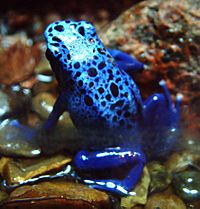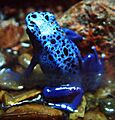Neobatrachians facts for kids
Quick facts for kids Neobatrachians |
|
|---|---|
 |
|
| Dendrobates azureus | |
| Scientific classification | |
| Kingdom: | |
| Phylum: | |
| Subphylum: | |
| Class: | |
| Subclass: | |
| Order: | |
| Suborder: |
Neobatrachia
|
Neobatrachia is a major group, or suborder, of frogs and toads. It belongs to the larger group called Anura, which includes all frogs and toads. This suborder is the most "advanced" and by far the largest of the three main frog suborders.
With over 5,000 different species, Neobatrachia makes up more than 96% of all living frogs and toads found on Earth today. This means most of the frogs and toads you might see or learn about belong to this amazing group!
Contents
What are Neobatrachia?
Neobatrachia means "new frogs." This name helps us understand that these frogs are considered more recently evolved compared to other frog groups. Scientists classify animals into groups to help us understand their relationships. A "suborder" is a group smaller than an order but larger than a family.
This group includes a huge variety of frogs and toads. They live in almost every habitat around the world, except for very cold places like Antarctica. You can find them in rainforests, deserts, mountains, and even your backyard!
Amazing Diversity
The Neobatrachia group is incredibly diverse. This means its members come in many different shapes, sizes, and colors. Some are tiny, only a few centimeters long, while others are quite large.
For example, the famous Poison dart frogs, known for their bright colors and powerful skin toxins, are part of Neobatrachia. So are the common tree frogs that climb trees and the toads you might see hopping in gardens.
This huge variety helps them survive in many different environments. Each species has special features that help it find food, avoid predators, and reproduce in its specific home.
Life Cycle of Frogs
Like all amphibians, frogs and toads in the Neobatrachia group go through a fascinating metamorphosis. Their life usually starts as an egg laid in water. These eggs hatch into tadpoles, which are aquatic (water-dwelling) larvae.
Tadpoles typically have gills for breathing underwater and a tail for swimming. As they grow, they slowly change. They develop legs, their gills disappear, and lungs form for breathing air. Their tail also shortens and eventually vanishes.
Once metamorphosis is complete, the young frog or toad leaves the water. It is now ready to live on land, though many still stay close to water sources. This amazing transformation allows them to use different parts of the environment at different stages of their lives.
Importance in Ecosystems
Frogs and toads play a very important role in their ecosystems. They are often called "bio-indicators" because their health can tell us a lot about the health of the environment. If frogs are struggling, it can be a sign that something is wrong with the air, water, or land.
They help control insect populations by eating many different kinds of insects, including mosquitoes. In turn, frogs and tadpoles are a food source for many other animals, such as birds, snakes, and fish. This makes them a key part of the food web.
Conservation Efforts
Sadly, many frog and toad species, including those in Neobatrachia, are facing threats. These threats include habitat loss, pollution, climate change, and diseases. Scientists and conservationists are working hard to protect these amazing creatures.
Efforts include protecting their natural homes, reducing pollution, and studying diseases that affect them. By learning more about frogs and toads, we can help ensure they continue to thrive for future generations.
Images for kids


